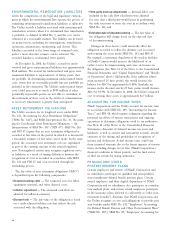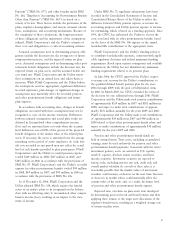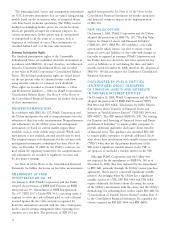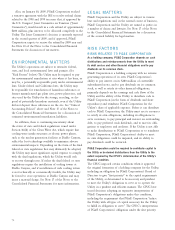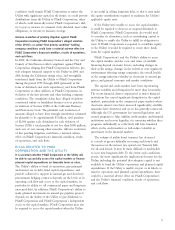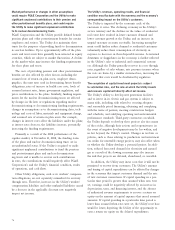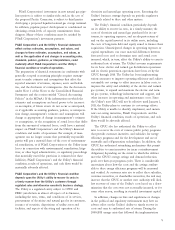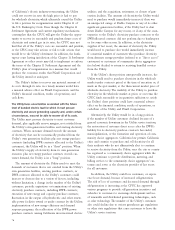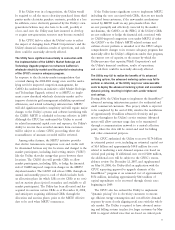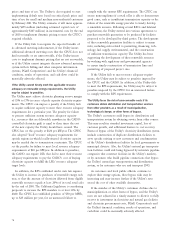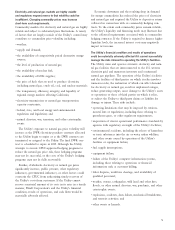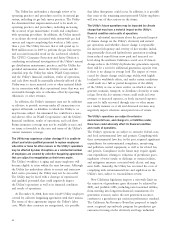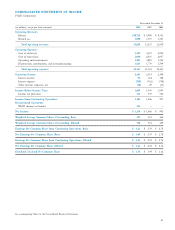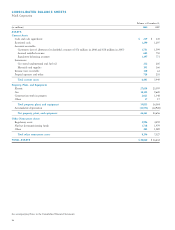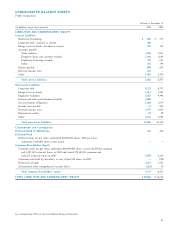PG&E 2008 Annual Report Download - page 77
Download and view the complete annual report
Please find page 77 of the 2008 PG&E annual report below. You can navigate through the pages in the report by either clicking on the pages listed below, or by using the keyword search tool below to find specific information within the annual report.75
electricity and natural gas operating assets. Executing the
Utility’s business strategy depends on periodic regulatory
approvals related to these and other matters.
The Utility’s fi nancial condition particularly depends
on its ability to recover in rates, in a timely manner, the
costs of electricity and natural gas purchased for its cus-
tomers, its operating expenses, and an adequate return of
and on the capital invested in its utility assets, including
the costs of long-term debt and equity issued to fi nance their
acquisition. Unanticipated changes in operating expenses or
capital expenditures can cause material differences between
forecasted costs used to determine rates and actual costs
incurred, which, in turn, affect the Utility’s ability to earn its
authorized rate of return. The Utility’s revenue requirements
for its basic electric and natural gas distribution operations
and its electric generation operations have been set by the
CPUC through 2010. The Utility has been implementing
various measures to improve operating effi ciency and achieve
sustainable cost savings to offset increases in labor costs, to
improve the safety and reliability of the electric and natural
gas systems, to expand and maintain the electric and natu-
ral gas systems, technology infrastructure and support, and
other increases in operating and maintenance costs. Since
the Utility’s next GRC will not be effective until January 1,
2011, the Utility plans to continue its cost-savings efforts.
If the Utility is unable to identify, implement, and sustain
new cost-saving initiatives, PG&E Corporation’s and the
Utility’s fi nancial condition, results of operations, and cash
fl ows would be adversely affected.
The CPUC also has authorized the Utility to collect
rates to recover the costs of various public policy programs
that provide customer incentives and subsidies for energy
effi ciency programs and for the development and use of
renewable and self-generation technologies. In addition, the
CPUC has authorized ratemaking mechanisms that permit
the utilities to earn incentives (or incur a reimbursement
obligation) depending on the extent to which the utilities
meet the CPUC’s energy savings and demand reduction
goals over three-year program cycles. There is considerable
uncertainty about how the costs and the savings attribut-
able to these energy effi ciency programs will be measured
and verifi ed. As customer rates rise to refl ect these subsidies,
customer incentives, or shareholder incentives, the risk may
increase that the CPUC or another state authority will disal-
low recovery of some of the Utility’s costs based on a deter-
mination that the costs were not reasonably incurred, or for
some other reason, resulting in stranded investment capital.
In addition, changes in laws and regulations or changes
in the political and regulatory environment may have an
adverse effect on the Utility’s ability to timely recover its
costs and earn its authorized rate of return. During the
2000-2001 energy crisis that followed the implementation
PG&E Corporation’s investment in new natural gas pipe-
lines projects is subject to similar risks and, in the case of
the proposed Pacifi c Connector, is subject to third parties
developing a proposed liquefi ed natural gas storage terminal.
In addition, pipeline project development is conditioned on
obtaining certain levels of capacity commitments from
shippers. Many of these conditions must be satisfi ed by
PG&E Corporation’s investment partners.
PG&E Corporation’s and the Utility’s fi nancial statements
refl ect various estimates, assumptions, and values, and
changes to these estimates, assumptions, and values, as
well as the application of and changes in accounting rules,
standards, policies, guidance, or interpretations, could
materially affect PG&E Corporation’s and the Utility’s
fi nancial condition or results of operations.
The preparation of fi nancial statements in conformity with
generally accepted accounting principles requires manage-
ment to make estimates and assumptions that affect the
reported amounts of revenues, expenses, assets and liabili-
ties, and the disclosure of contingencies. (See the discussion
under Note 1 of the Notes to the Consolidated Financial
Statements and the section entitled “Critical Accounting
Policies” in the MD&A.) If the information on which the
estimates and assumptions are based proves to be incorrect
or incomplete, if future events do not occur as anticipated,
or if applicable accounting guidance, policies, or interpreta-
tion change, management’s estimates and assumptions will
change as appropriate. A change in management’s estimates
or assumptions, or the recognition of actual losses that differ
from the amount of estimated losses, could have a material
impact on PG&E Corporation’s and the Utility’s fi nancial
condition and results of operations. For example, if man-
agement can no longer assume that potentially responsible
parties will pay a material share of the costs of environmen-
tal remediation, or if PG&E Corporation or the Utility incur
losses in connection with environmental remediation; litiga-
tion; or other legal, administrative, or regulatory proceedings
that materially exceed the provision it estimated for these
liabilities, PG&E Corporation’s and the Utility’s fi nancial
condition, results of operations, and cash fl ows would be
materially adversely affected.
PG&E Corporation’s and the Utility’s fi nancial condition
depends upon the Utility’s ability to recover its costs in
a timely manner from the Utility’s customers through
regulated rates and otherwise execute its business strategy.
The Utility is a regulated entity subject to CPUC and
FERC jurisdiction in almost all aspects of its business,
including the rates, terms, and conditions of its services,
procurement of electricity and natural gas for its customers,
issuance of securities, dispositions of utility assets and
facilities, and aspects of the siting and operation of its



